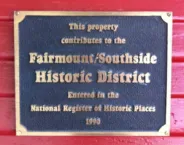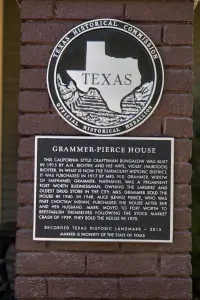The Fairmount National Historic District is the largest historic neighborhood in the southwestern United States. It is registered in the National Register of Historic Places and is comprised of more than 1,000 contributing structures to the district.
Markers are available to contributing structures noting their contribution to the district as well as houses deemed a historic site by the city or appointed a Registered Texas Historic Landmark by the state. Although contributing to the Fairmount district, individual properties may also be nominated for individual listing in the National Register through research by a property’s owner through their own research, the research of a historian or other interested party.
Fairmount National Historic District Plaque
Is your house a contributing structure to the Fairmount National Historic District? If so, why not proudly show it off with a Fairmount plaque? To see if your house is currently contributing, click here. Prices are $240 for bronze and $155 for aluminum. Please contact Martin Dahl, Fairmount director of preservation for availability at preservation@historicfairmount.com

City of Fort Worth Landmark Marker
If you have driven around Fairmount and looked closely, or particularly down Elizabeth Blvd. in Ryan Place, you might have noticed the bronze round markers with a star in the center. This type of marker is available through the City of Fort Worth Historic and Cultural Landmarks Commission for houses deemed a historic site by the city. Criteria for Historic Designation by the city. For more information on obtaining one of these markers and current pricing, please contact Liz Casso at 817-392-8037.

Registered Texas Historic Landmark Marker
Recorded Texas Historic Landmarks are properties judged to be historically and architecturally significant. The Texas Historical Commission (THC) awards RTHL designation to buildings at least 50 years old that are worthy of preservation for their architectural and historical associations.
This is a designation that comes with a measure of protection under state law. The purchase and display of the RTHL marker is a required component of the designation process. The owner’s consent is required to nominate a property as a RTHL. Please refer to the Recorded Texas Historic Landmarks brochure for a full explanation of the designation and its legal requirements.
To learn more about the marker process, marker prices and the RTHL designation, visit the Texas Historical Commission website at:
http://www.thc.state.tx.us/preserve/projects-and-programs/recorded-texas-historic-landmarks
You may also contact the Tarrant County Historical Commission marker chair, Ellen Timberlake-Volz at timberlake-volz@sbcglobal.net

National Register of Historic Places
The National Register nomination process usually starts with your State Historic Preservation Office* (SHPO). Contact your SHPO or check their web page for National Register information, research materials, and necessary forms to begin the nomination process. If the property is on federal or tribal land, then the process starts with the Federal Preservation Office or Tribal Preservation Office. (More on FPO and TPOs.)
How are Properties Evaluated?
To be considered eligible, a property must meet the National Register Criteria for Evaluation. This involves examining the property’s age, integrity, and significance.
• Age and Integrity. Is the property old enough to be considered historic (generally at least 50 years old) and does it still look much the way it did in the past?
• Significance. Is the property associated with events, activities, or developments that were important in the past? With the lives of people who were important in the past? With significant architectural history, landscape history, or engineering achievements? Does it have the potential to yield information through archeological investigation about our past?
The National Register designation imposes no restrictions on property owners. Those receiving grant assistance or federal tax credits for rehabilitation projects, however, must adhere to certain standards. With a National Register designation, the property receives extra consideration before any federal projects, such as highway construction, are undertaken. To nominate a property, the owner’s consent is required.
Listing a Property in the National Register:
- Provides prestigious recognition to significant properties.
- Encourages the preservation of historic properties.
- Provides information about historic properties for local and statewide planning purposes.
- Helps promote tourism and economic development.
- Provides basic eligibility for financial incentives, including federal tax credits for the rehabilitation of historic buildings.
The National Register does not:
- Restrict in any way a private property owner’s ability to alter, manage or dispose of a property.
- Require that properties be maintained, repaired or restored.
- Allow the individual listing of private property over an owner’s objection.
- Allow the listing of historic districts over a majority of property owners’ objection.
- Require public access to private property
Learn more at:
http://www.thc.state.tx.us/preserve/projects-and-programs/national-register-historic-places
https://www.nps.gov/nr/national_register_fundamentals.htm#start
